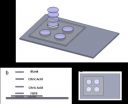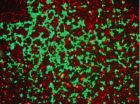(Press-News.org) Xpert MTB/RIF, a recently implemented tuberculosis (TB) test, has the potential to control the TB epidemic in India, but only if the current, narrow, implementation strategy is replaced by a more ambitious one that is better funded, also includes the private sector, and better referral networks are developed between public and private sectors, according to new research published in this week's PLOS Medicine. The study by David Dowdy, from Johns Hopkins University, United States, and colleagues is a mathematical model that suggests alternative strategies that include engagement with both the public and private sector may have a bigger population level impact on TB than the current implementation strategy of using Xpert for only those at risk of drug-resistance or HIV infection.
Xpert MTB/RIF is a new TB diagnostic that is more sensitive than other diagnostics in current widespread use and can detect resistance to certain antibiotics, but its cost is substantial, and the Indian health-care system is fragmented and heavily privatized with the majority of the population seeking private healthcare initially. Currently, due to resource constraints, the Indian Revised National Tuberculosis Control Programme is mainly implementing Xpert MTB/RIF as a rapid drug susceptibility test method among selected patients seeking care in the public sector.
The researchers explored the impact of six different rollout strategies on the incidence of tuberculosis (the number of new cases of tuberculosis in the population per year) by developing a mathematical model of tuberculosis transmission, care-seeking behavior, and diagnostic/treatment practices in India. A scenario that added access to Xpert MTB/RIF for 20% of all individuals with tuberculosis symptoms seeking diagnosis in the public sector and 20% of individuals seeking care from qualified private practitioners to the current national strategy was predicted to reduce the incidence of tuberculosis by 14.1% compared to the current national strategy which is only expected to reduce incidence by 0.2%. However, this scenario required more than 2,200 Xpert machines and reliable treatment referral. Notably, a scenario tested that encouraged informal providers to refer suspected tuberculosis cases to the public sector for diagnosis using currently available tests predicted a greater impact on the incidence of tuberculosis than Xpert scale-up within the public sector alone.
The authors acknowledge that their findings are subject to uncertainties in the assumptions made in their model but note, "Xpert [MTB/RIF] ... could substantially reduce the burden of TB disease due to poor diagnosis in India; however, this impact depends not only on the accuracy of the test, but also on the behavior of both patients and providers, their level of access to new tools, and quality TB treatment following diagnosis."
They conclude, "any Xpert [MTB/RIF] rollout strategy must also consider the complex health-care infrastructure into which the test is being rolled out. To achieve maximum impact of novel diagnostics, India should engage the private sector, improve quality of care across all sectors, and dramatically increase resources."
INFORMATION:
Research Article
Funding: The project was funded by grants from the Bill & Melinda Gates Foundation (OPP1061487) and Canadian Institutes of Health Research (MOP 123291). The funders had no role in study design, data collection and analysis, decision to publish, or preparation of the manuscript.
Competing Interests: MP serves as a consultant to the Bill & Melinda Gates Foundation (BMGF). MP is also a member of the Editorial Board of PLOS Medicine.
Citation: Salje H, Andrews JR, Deo S, Satyanarayana S, Sun AY, et al. (2014) The Importance of Implementation Strategy in Scaling Up Xpert MTB/RIF for Diagnosis of Tuberculosis in the Indian Health-Care System: A Transmission Model. PLoS Med 11(7): e1001674. doi:10.1371/journal.pmed.1001674
Author Affiliations:
Johns Hopkins Bloomberg School of Public Health, UNITED STATES
Massachusetts General Hospital, UNITED STATES
Indian School of Business, INDIA
McGill University, CANADA
McGill University Health Centre, CANADA
Johns Hopkins School of Medicine, UNITED STATES
Johns Hopkins University, UNITED STATES
IN YOUR COVERAGE PLEASE USE THIS URL TO PROVIDE ACCESS TO THE FREELY AVAILABLE PAPER:
http://www.plosmedicine.org/article/info%3Adoi%2F10.1371%2Fjournal.pmed.1001674
Contact:
David Dowdy
Johns Hopkins Bloomberg School of Public Health
UNITED STATES
+1 (410) 614-0902
ddowdy@jhsph.edu
Rollout strategy for diagnostic test in India may impact TB
2014-07-15
ELSE PRESS RELEASES FROM THIS DATE:
Molecular 'eat now' signal makes cells devour dying neighbors
2014-07-15
A team of researchers has devised a Pac-Man-style power pellet that gets normally mild-mannered cells to gobble up their undesirable neighbors. The development may point the way to therapies that enlist patients' own cells to better fend off infection and even cancer, the researchers say.
A description of the work will be published July 15 in the journal Science Signaling.
"Our goal is to build artificial cells programmed to eat up dangerous junk in the body, which could be anything from bacteria to the amyloid-beta plaques that cause Alzheimer's to the body's own ...
Neurons, brain cancer cells require the same little-known protein for long-term survival
2014-07-15
CHAPEL HILL, N.C. – Researchers at the UNC School of Medicine have discovered that the protein PARC/CUL9 helps neurons and brain cancer cells override the biochemical mechanisms that lead to cell death in most other cells. In neurons, long-term survival allows for proper brain function as we age. In brain cancer cells, though, long-term survival contributes to tumor growth and the spread of the disease.
These results, published in the journal Science Signaling, not only identify a previously unknown mechanism used by neurons for their much-needed survival, but show that ...
Rollout strategy is key to battling India's TB epidemic, researchers find
2014-07-15
A new study led by Johns Hopkins Bloomberg School of Public Health researchers suggests that getting patients in India quickly evaluated by the right doctors can be just as effective at curbing tuberculosis (TB) as a new, highly accurate screening test.
While ideally all suspected TB cases would be evaluated with the new test, it is primarily being used only on the highest-risk populations and only in public health clinics, partly because of its cost and the complexity of the nation's health care system. This slows diagnosis of a disease that must be caught early, the ...
New assay to spot fake malaria drugs could save thousands of lives
2014-07-15
CORVALLIS, Ore. – Chemists and students in science and engineering at Oregon State University have created a new type of chemical test, or assay, that's inexpensive, simple, and can tell whether or not one of the primary drugs being used to treat malaria is genuine – an enormous and deadly problem in the developing world.
The World Health Organization has estimated that about 200,000 lives a year may be lost due to the use of counterfeit anti-malarial drugs. When commercialized, the new OSU technology may be able to help address that problem by testing drugs for efficacy ...
3-D nanostructure could benefit nanoelectronics, gas storage
2014-07-15
A three-dimensional porous nanostructure would have a balance of strength, toughness and ability to transfer heat that could benefit nanoelectronics, gas storage and composite materials that perform multiple functions, according to engineers at Rice University.
The researchers made this prediction by using computer simulations to create a series of 3-D prototypes with boron nitride, a chemical compound made of boron and nitrogen atoms. Their findings were published online July 14 in the Journal of Physical Chemistry C.
The 3-D prototypes fuse one-dimensional boron nitride ...
TGen-led study finds likely origin of lung fungus invading Pacific Northwest
2014-07-15
FLAGSTAFF, Ariz. - Cryptococcus gattii, a virulent fungus that has invaded the Pacific Northwest is highly adaptive and warrants global "public health vigilance," according to a study by an international team led by the Translational Genomics Research Institute (TGen).
C. gattii, which likely originated in Brazil, is responsible for dozens of deaths in recent years since it was first found in 1999 on Vancouver Island, British Columbia, Canada, well outside its usual tropical habitats.
"We identified several genes that may make the outbreak strains more capable of surviving ...
Rice nanophotonics experts create powerful molecular sensor
2014-07-15
Nanophotonics experts at Rice University have created a unique sensor that amplifies the optical signature of molecules by about 100 billion times. Newly published tests found the device could accurately identify the composition and structure of individual molecules containing fewer than 20 atoms.
The new imaging method, which is described this week in the journal Nature Communications, uses a form of Raman spectroscopy in combination with an intricate but mass reproducible optical amplifier. Researchers at Rice's Laboratory for Nanophotonics (LANP) said the single-molecule ...
SLU scientists hit 'delete': Removing regions of shape-shifting protein explains how blood clots
2014-07-15
ST. LOUIS – In results recently published in Proceedings of the National Academy of Sciences (PNAS), Saint Louis University scientists have discovered that removal of disordered sections of a protein's structure reveals the molecular mechanism of a key reaction that initiates blood clotting.
Enrico Di Cera, M.D., chair of the Edward A. Doisy department of biochemistry and molecular biology at Saint Louis University, studies thrombin, a key vitamin K-dependent blood-clotting protein, and its inactive precursor prothrombin (or coagulation factor II).
"Prothrombin is essential ...
New skin gel fights breast cancer without blood clot risk
2014-07-15
CHICAGO --- A gel form of tamoxifen applied to the breasts of women with noninvasive breast cancer reduced the growth of cancer cells to the same degree as the drug taken in oral form but with fewer side effects that deter some women from taking it, according to new Northwestern Medicine® research.
Tamoxifen is an oral drug that is used for breast cancer prevention and as therapy for non-invasive breast cancer and invasive cancer.
Because the drug was absorbed through the skin directly into breast tissue, blood levels of the drug were much lower, thus, potentially ...
Game theory model reveals vulnerable moments for cancer cells' energy production
2014-07-15
Cancer's no game, but researchers at Johns Hopkins are borrowing ideas from evolutionary game theory to learn how cells cooperate within a tumor to gather energy. Their experiments, they say, could identify the ideal time to disrupt metastatic cancer cell cooperation and make a tumor more vulnerable to anti-cancer drugs.
"The reality is that we still can't cure metastatic cancer that has spread from its primary organ and game theory adds to our efforts to attack the problem," says Kenneth J. Pienta, M.D., the Donald S. Coffey Professor of Urology at the Johns Hopkins ...




